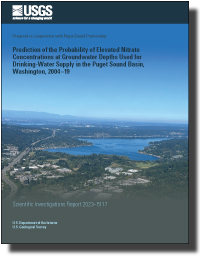Prediction of the Probability of Elevated Nitrate Concentrations at Groundwater Depths Used for Drinking-Water Supply in the Puget Sound Basin, Washington, 2004–19
Links
- Document: Report (16 MB pdf) , HTML , XML
- Data Release: USGS Data Release - Index of vulnerability for elevated nitrates in groundwater in the Puget Sound Basin, Washington, 2000–2019
- Download citation as: RIS | Dublin Core
Abstract
The Puget Sound basin encompasses the 13,700-square-mile area that drains to the Puget Sound and the adjacent marine waters of Washington State. Well more than 4 million people live within the basin, with numbers continuing to increase, who rely on the basin’s natural resources including groundwater. The Puget Sound Partnership was created by a Washington State statute to implement a science-based recovery of the Puget Sound to help address impacts to these resources. As part of the recovery, the partnership developed the Puget Sound Vital Signs as measures of ecosystem health that guide the assessment of progress toward Puget Sound recovery goals. The Puget Sound Partnership Leadership Council adopted a Drinking Water Vital Sign associated with human health and quality of life, recognizing certain indicators as integral to the sustainability of Puget Sound recovery efforts. One such Vital Sign indicator was the vulnerability of groundwater throughout the aquifers of the Puget Sound basin to elevated nitrate concentrations as defined by the probability of exceeding 2 milligrams/liter (mg/L) at a specific location and well depth. The U.S. Geological Survey (USGS) led the effort to characterize groundwater vulnerability. For this study, groundwater vulnerability refers to a probability with which a contaminant applied at or near the land surface can migrate to the aquifer of interest for a given set of land-use practices. Nitrate concentration data were selected for evaluation because elevated nitrate concentrations are typically caused by anthropogenic activities and have been associated with deleterious impacts on human health.
To identify groundwater vulnerability to elevated nitrate concentrations, logistic regression was used to relate anthropogenic (human associated) and natural variables to the occurrence of elevated nitrate concentrations in untreated groundwater from large public water supply system wells found within the Washington State Department of Health Sentry database. Variables that were analyzed included well depth, soil hydraulic conductivity, precipitation, population density, fertilizer application amounts, and land-use types. Statistically significant models that predicted the probabilities of groundwater nitrate concentrations greater than 2 mg/L based on the predictor variables were created for the time periods 2000–04, 2005–09, 2010–14, and 2015–19. For all time periods, well depth and a measure of the abundance of urban and agricultural land over or near the well consistently helped explain the vulnerability of the well to elevated nitrate concentrations defined as a probability of exceeding 2 mg/L of nitrate. Precipitation and (or) soil hydraulic conductivity were also important predictor variables in the models.
The models for each time period were used to create maps of groundwater vulnerability at 150- and 300-foot depths throughout the Puget Sound basin. As expected, the most vulnerable locations were associated with shallower well depths and increased agriculture and urban land cover. Across all four time periods, groundwater vulnerability throughout the Puget Sound was low, with probabilities of exceeding 2 mg/L concentrations of nitrate at depths at 150 and 300 feet typically less than 50 percent. Results also found a slight decrease in probabilities of elevated nitrate concentrations throughout the basin over time. More specifically, additional statistical tests found that groundwater with probabilities of less than about 60 percent declined from 2000 to 2019 and represented more than 75 percent of the modeled Puget Sound basin aquifer. Wells with greater than 60 percent probability increased over the same time period but represented only about 25 percent of the aquifer. The maps and statistical analysis presented in the study provide valuable and informative evaluation of the vulnerability of groundwater in the Puget Sound basin to elevated nitrate concentrations. The probability maps do not represent measured nitrate concentrations in groundwater, but rather they present the probability that nitrate concentrations exceed 2 mg/L. The models and predictions from this study are a viable indicator for the Puget Sound Partnership’s Healthy Human Population—Drinking Water Vital Sign. The logistic regression modeling approach presented here benefits water managers by allowing them to assess temporal trends in a range of probabilities, explore vulnerability changes as new regional land cover and anthropogenic data are generated, and distinguish vulnerabilities at different depths within the aquifer.
Suggested Citation
Black, R.W., Wright, E.E., Bright, V.A.L., and Headman, A.O., 2023, Prediction of the probability of elevated nitrate concentrations at groundwater depths used for drinking-water supply in the Puget Sound basin, Washington, 2004–19: U.S. Geological Survey Scientific Investigations Report 2023–5117, 40 p., https://doi.org/10.3133/sir20235117.
ISSN: 2328-0328 (online)
Study Area
Table of Contents
- Abstract
- Introduction
- Methods of Investigation
- Logistic Regression Model Results
- Probability of Elevated Nitrate Concentrations in Groundwater of the Puget Sound Basin
- Temporal Changes in the Probability of Elevated Nitrate Concentrations
- Summary
- References Cited
| Publication type | Report |
|---|---|
| Publication Subtype | USGS Numbered Series |
| Title | Prediction of the probability of elevated nitrate concentrations at groundwater depths used for drinking-water supply in the Puget Sound basin, Washington, 2004–19 |
| Series title | Scientific Investigations Report |
| Series number | 2023-5117 |
| DOI | 10.3133/sir20235117 |
| Publication Date | December 28, 2023 |
| Year Published | 2023 |
| Language | English |
| Publisher | U.S. Geological Survey |
| Publisher location | Reston, VA |
| Contributing office(s) | Washington Water Science Center |
| Description | Report: vi, 40 p.; Data Release |
| Country | United States |
| State | Washington |
| Other Geospatial | Puget Sound basin |
| Online Only (Y/N) | Y |


